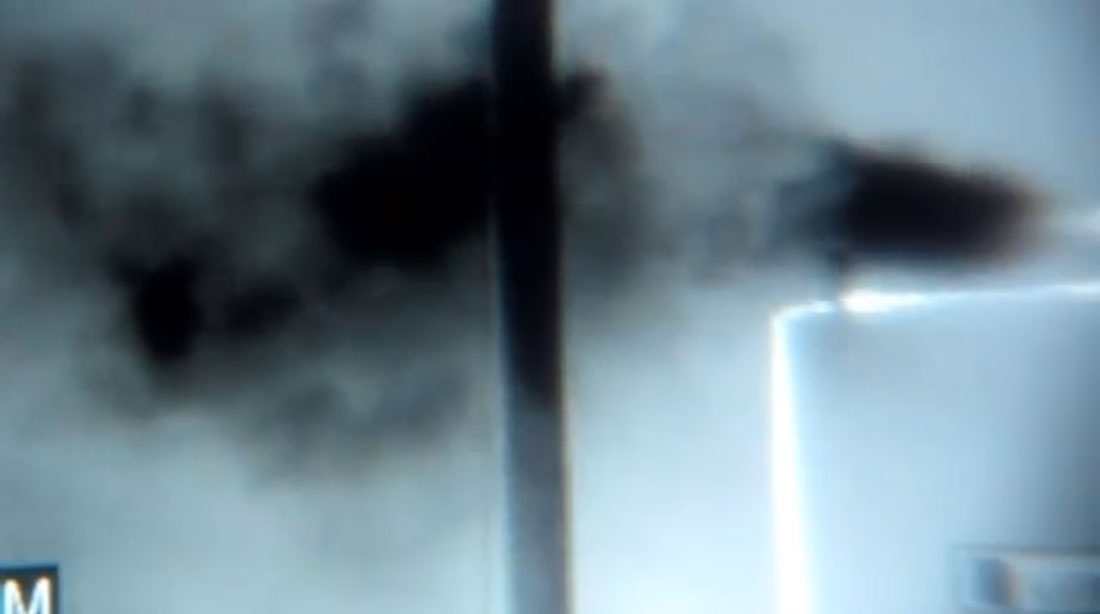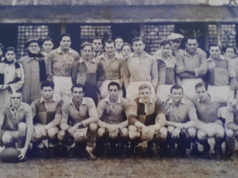The short video opens with a shot of a Chesapeake-produced water tank beneath a beautiful blue sky on the near East Side of Fort Worth. An infrared camera is turned on. Instantly the blue sky disappears, and in its place billowing plumes of thick black chemical gases fill the screen.
“That shit stinks,” says a voice off-camera.
“There’s a … park right there,” says another voice, as the camera pans to a children’s playground a couple of hundred feet from the tank, which holds the toxic brew that comes back out of the ground after a gas well is hydraulically fractured.
The video ends moments later. “I gotta get out of here,” says the first speaker, Calvin Tillman, the former mayor of DISH, Texas. “My head hurts.”
The video was shot at Delga Park along the Trinity Trails, next to the Greenwood neighborhood and just across I-35 from the Oakhurst neighborhood. The forward-looking infrared camera, or FLIR camera, photographs gases invisible to the naked eye. What it revealed was the furious stream of volatile organic compounds (VOCs) being belched from the tank. People living nearby and in the park might not even notice the gas, though they cannot fail to notice the acrid smell.
The video was made by ShaleTest.org, a nonprofit outfit founded in 2010 by Tillman and Tim Ruggiero to offer free air and water testing to people in neighborhoods affected by gas drilling who cannot afford to do their own.
Ironically, most of ShaleTest’s work thus far has been done far from North Texas, in the Marcellus Shale region in Pennsylvania and Western New York. But that changed dramatically when they began filming escaping gas from drilling sites in Fort Worth in late October. The Delga Park video, posted on YouTube, is the first local one. Several others, showing similarly dangerous VOCs being released from gas- industry sites around Fort Worth, appear on ShaleTest’s website. VOCs, according to the U.S. Environmental Protection Agency, can cause irritation in the eyes, nose, and throat; damage to internal organs; and possibly cancer.
“What we shot in just a few days makes it obvious how bad those gas releases are,” Tillman said. “And now that we have the camera available, we’re going to do it every few months. ShaleTest is going to do what the city and the Texas Commission on Environmental Quality won’t do.”
When Tillman discusses shale drilling, he becomes passionate — with good reason. He saw his little town of DISH, up in a corner of Denton County, become the epicenter of Barnett Shale drilling, with fracked wells ringing the town, pipelines crisscrossing property everywhere, and a huge complex of nine compressor stations at the edge of town (“Sacrificed to Shale,” Oct. 14, 2009).
The emissions from all of those installations killed thousands of trees and made livestock and humans so ill that people who could afford to move did. Tillman stayed as long as he could, trying to get the gas companies and compressor stations to mitigate their releases, but when his own sons began getting nosebleeds regularly and without apparent cause, he knew they had to leave too. By that time he had become an outspoken critic of the way gas companies were operating, which he saw as making profits at the expense of people’s health.
Ruggiero’s dream home in Decatur became a nightmare for him and his wife Christine when they discovered they didn’t own the mineral rights beneath their Wise County property and Aruba Petroleum began drilling just 300 feet away. Not long afterward, Tim, Christine, and their daughter Reilly began suffering from strange rashes and respiratory ailments. Like the Tillmans, the Ruggieros finally escaped to a new home in 2011 — and like Tillman, Ruggiero became an outspoken critic of the gas-drilling industry.
While both men saw the Barnett Shale as essentially a lost cause, they wanted to talk about their experiences to people who were just beginning to feel the onslaught of the shale gas industry.
“In April 2010, [Tillman] and I went out to the Marcellus Shale in the Pittsburgh area,” Ruggiero said. “We’d let some environmentalists know we were available to speak, and several town hall meetings were set up for us. And we did six or seven of those. I told my story, and [Tillman] told the people about what was going on in DISH with people getting sick there. As a result of that tour, with us seeing that those people were just beginning to go through what we’d already gone through … well, we knew someone had to help those people understand.”
One visit to a trailer home was particularly eye-opening. “We’d see black water coming out of their faucets, and that’s what they were bathing their kids in,” Ruggiero said. “They had no idea how bad that stuff was — or even what it was. They just knew the water changed when the drilling started.”
At the end of that April tour, the pair sat in an airport bar bemoaning the fact that no one was doing any air- or water- quality testing. They decided to put their money where their mouths were: Each wrote down on a bar napkin the sum that he was willing to put into a pot to try to help people in the Marcellus Shale.
Tillman wouldn’t say what the figures were but said that he and Ruggiero decided that at least 80 percent of the money would go directly to testing, adding, “It was a pretty good chunk of money for us, but we decided we had to do that. And if the money we committed to wound up helping one family, that was OK. If it was 10 families, well, that’s 10 families that wouldn’t otherwise be helped.”
That was the birth of ShaleTest, which thus far has helped several dozen families find out what nearby gas drilling is doing to the air they’re breathing.
With their combined stake, the men bought six Summa canisters — for collecting air samples — with enough cash left over to pay for testing what they collected, Ruggiero said. The first few canisters were used around DISH and then Ruggiero’s home. They purchased a few more canisters, then returned to Pennsylvania and took several samples there, including some baseline samples in areas where drilling had not yet begun. The contents of the canisters were all tested by EPA-certified labs. The results were given to the families or communities, who then decided what to do with those results. Sometimes, Ruggiero said, that meant people moving out of the area.
A year after starting, ShaleTest received a small grant from Earthworks, a group aimed at protecting communities and the environment from the impacts of irresponsible mineral and energy development. ShaleTest has received some private donations as well — though both men continue to work their regular jobs to support their families and the company.
Since its creation two years ago, ShaleTest has spent about $20,000 performing several dozen air-quality tests and a handful of water tests, according to Ruggiero’s estimates. The company has done fewer water quality tests because those can cost as much as $1,000 each.
ShaleTest doesn’t own a specialized FLIR gas-detection camera, which costs about $60,000, but an ally in Pennsylvania who owns one has been willing to come to Texas to document the streams of pollution coming off gas facilities here.
“We’ve grown considerably in the last two years,” Ruggiero said. “People are joining ShaleTest, volunteering their time to find town halls for us to speak in, and finding people who have been affected who would like air testing done.”
Ideally, Ruggiero would like to see a ShaleTest representative in every state where shale gas drilling is going on. “It’s something we’re working on, because the officials in places like the Marcellus Shale are telling people there is no problem — when we know there is,” Ruggiero said. “So someone has to be there for those people.”
He pointed to the video of Delga Park. In that case, he said, where the visual evidence of damage is so strong, he can’t understand why the gas companies can’t simply be forced to clean it up.
“Of course that would cost money,” he said. “Well, too bad. We’re not trying to shut the gas company down. We’re trying to get them to use a filter, to use a VOC recovery system. If they would do that, [we] would have nothing to say.”
Gary Hogan, longtime Fort Worth gas-drilling activist and a member of both of the city’s gas-drilling ordinance committees, saw the ShaleTest Delga Park video and called it “damning,” both because of the volume of poisons being released into the air and because the city should have been doing similar camerawork for a long time.
“You would imagine that Fort Worth would have its own FLIR camera to monitor the sites, but they won’t buy one,” Hogan said. “If they did they could have their inspectors move from site to site and notify the gas companies that have problems and have them do remediation. It’s really not difficult. It shouldn’t have to be up to ShaleTest to do it. But the way it is now, with the city refusing to buy the equipment, that’s what we have to deal with.”
Fort Worth Weekly e-mailed a link to the YouTube video of Delga Park to Mayor Betsy Price and called the offices of council members Zim Zimmerman and Jungus Jordan and asked for comment. The Weekly got no response.
Tillman was not surprised. “I don’t think the city wants to know, because once you know, you can’t un-know,” he said. “As long as they ignore footage like Chesapeake’s escaping gas at Delga Park, they get to keep a level of deniability.”
Ruggiero acknowledged that Shale-Test has not had a major impact on the way gas companies do business. But at least families have been alerted to what is going on, he said. And he figures the vitriolic references to ShaleTest on industry websites are an indication that the nonprofit’s activities are being noticed.
Tillman agreed. “We’ve done a lot of work in a lot of other states, but it’s time to bring it back home and do it here in our backyard,” he said. “It would be good if we had someone driving around Fort Worth every day with a camera to see what’s going on, because what’s going on is dangerous, whether you see it or not.”














ox interviews mayor of DISH, Texas; blames natural gas development, transport for toxins in the air, benzene in blood.
Tillman in the press: “Six months ago, nobody knew that facilities like this would be spewing benzene. Someone could come in here and look at us and say, ‘You know what? They’ve sacrificed you. You’ve been sacrificed for the good of the shale.’” (Scientific American, 3/30/10)
A little more than a month later, Texas Dept. of State Health Services debunks that claim: “Biological test results from a Texas Department of State Health Services investigation in Dish, Texas, indicate that residents’ exposure to certain contaminants was not greater than that of the general U.S. population.” (DSHS report, May 12, 2010)
More from the agency: “DSHS paid particular attention to benzene because of its association with natural gas wells. The only residents who had higher levels of benzene in their blood were smokers. Because cigarette smoke contains benzene, finding it in smokers’ blood is not unusual.”
And Calvin’s little boy’s nosebleeds were from smoking too? yeah right Andrew…. who do you chose to believe…..a state in bed with the industry or innocent people whose lives have been literally “moved” so the nose bleeds would stop !
There was a young mother that was from DIsh who ended up using a walker and not understanding why she was so sick and moved to Ft Worth and got better only to relapse when the drilling started up near her in Ft Worth.
I asked the City of Arlington for the third year in a row at budget time to buy a FLIR camera and still no action…..but thankfully we have shaletest!!
does shaletest own this camera? how did they pay for it? how is it different from a regular infrared camera? will they come to other areas of the country with this?
This is the FLIR GasFindIR footage that was used in this sequence:
http://www.youtube.com/watch?v=2tBhLjYSj2w&feature=youtu.be
All the people involved in ShaleTest are unsung heroes in the communities they serve. They are the oxen carrying the yoke that the State and Feds should be doing. Infrared pics don’t lie. They expose the ineptitude and corruption of present and past elected officials, especially the last three FW mayors: Barr, Moncrief and Price who carry the yoke for dirty industry.
That film was done in 2012. It is now 2018, and I would like to know what the wells are doing now. I run by them almost every day. Is Fort Worth basically toxic?